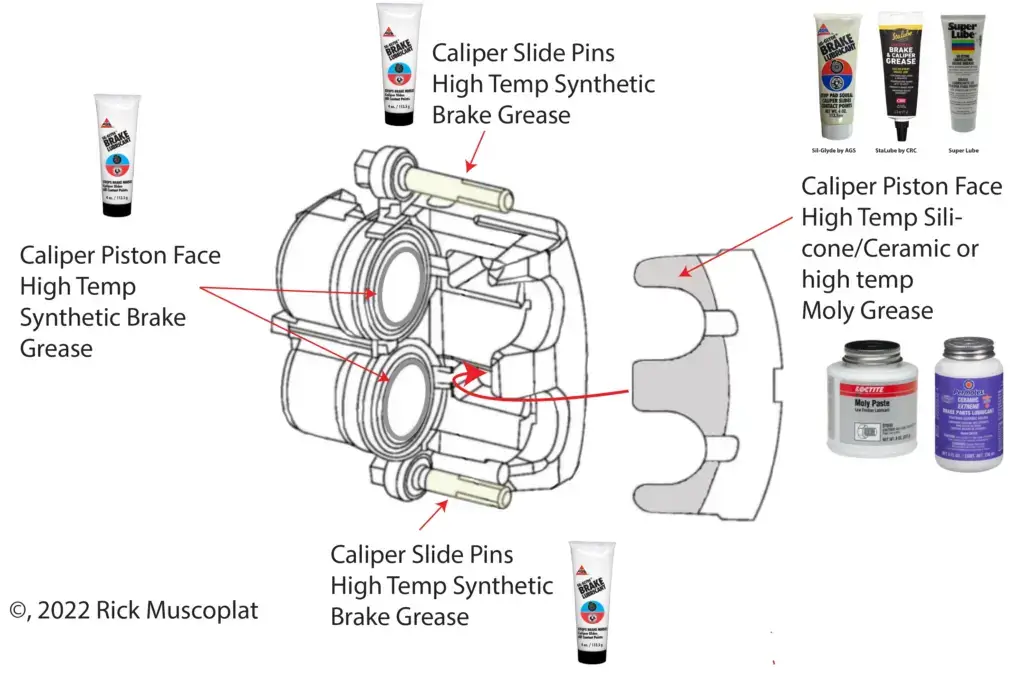Learn the Best Greases for Brake Jobs
Use the right greases for brake jobs to reduce noise and prevent caliper seizing
There are many types and brands of brake lubricants. Some DIYers use anti-seize products because they’ve seen them used on youtube videos. That’s bad advice because anti-seize products should never be used on brakes (more on that later). Others use chassis lubes, even though they’re not rated for the high temperatures found in brakes. Forget what you’ve seen on youtube; here’s the straight scoop on the best greases for brake jobs and where to use them.
Brake grease does three jobs — it lubricates, prevents corrosion and dampens brake vibrations.
1) Lubrication – When applied to the caliper slide pins, grease allows the pins to slide smoothly even at high temperatures.
2) A dielectric grease reduces corrosion and galvanic action, preventing slide pin seizing for years.
3) Grease dampens the brake vibration transfer from the brake pad backing plates to the caliper, steering knuckle, strut and spring, thereby reducing brake noise.
The best brake greases for brake jobs
Silicone-based greases
Use a silicone-based grease to lubricate caliper slide pins. A silicone grease doesn’t damage the slide pin rubber boots, handles the high heat, and enhances slide pin movement. Silicone brake grease is also dielectric, so it reduces corrosion due to water infiltration and reduces corrosion due to galvanic action between dissimilar metals.
Use silicone-based brake grease under the anti-rattle clips to reduce corrosion and prevent rust jacking that causes the brake pad “T-heads” from seizing in the brake caliper abutment.
Use silicone-based grease on the noise reduction shims where they contact the caliper body and caliper piston face. Silicone grease dampens brake vibrations and reduces vibration transfer
Where to use Molybdenum brake lubricant
Molybdenum (Moly) grease can also be used to dampen vibration and prevent vibration transfer from one metal component to another.
Use Moly grease where you have metal-to-metal contact between the backing plate/noise reduction shim and contact with the caliper
Use silicone brake lubricant on:
• Caliper slide pins
• Under anti-rattle clips to reduce corrosion
• On the face of the caliper piston to dampen vibrations
• On the noise reduction shims where they contact the brake caliper to dampen vibration
Why anti-seize shouldn’t be used in brake applications
Many people apply anti-seize to caliper pins, to the back of noise reduction shims and on anti-rattle clips. But anti-seize is not a lubricant. It’s not designed to help sliding parts move smoothly. It’s designed for one job and one job only; to prevent metal parts from seizing due to galvanic action or corrosion.
Anti-seize is NOT approved for use on brakes because it can’t handle high temperatures.
The specs on anti-seize packaging may mislead you into thinking it’s safe for use on brakes. For example, a quick glance a the spec sheet shows that anti-seize can handle temperatures up to 2,600°F. That’s way more than any brake system can produce. But that’s a misreading of the spec sheet.
The base lubricant in anti-seize can only handle up to 350°F. After that, the lube cooks and crusts. It’s only the aluminum, copper, nickle, and graphite fillers that last up to 2,600°F. That’s great for preventing seizing. But once the grease is gone, the fillers aren’t actually lubricants, which is what you need for caliper slide pins.
Here’s the full description from CRC Industries on their anti-seize products:
“Anti-seize lubricants are specialty lubricants that reduce friction between threaded and mated metal parts as well as prevent corrosion and seizure of parts under pressure and at temperatures well beyond the performance of conventional lubricants. Essentially they are two-part systems comprised of a base grease that serves to lubricate parts up to maximum temperature rating of the grease (usually about 350° F.) Secondly, the grease acts as a carrier for special fillers that provide the compound with its anti-seizing, anti-corrosion properties under high pressures and at elevated temperatures (up to 2600° F.). The special fillers are what differentiates anti-seize compounds from conventional lubricants and give each type of anti-seize lubricant its own specific properties.” — CRC Industries
©, 2022 Rick Muscoplat
Posted on by Rick Muscoplat

